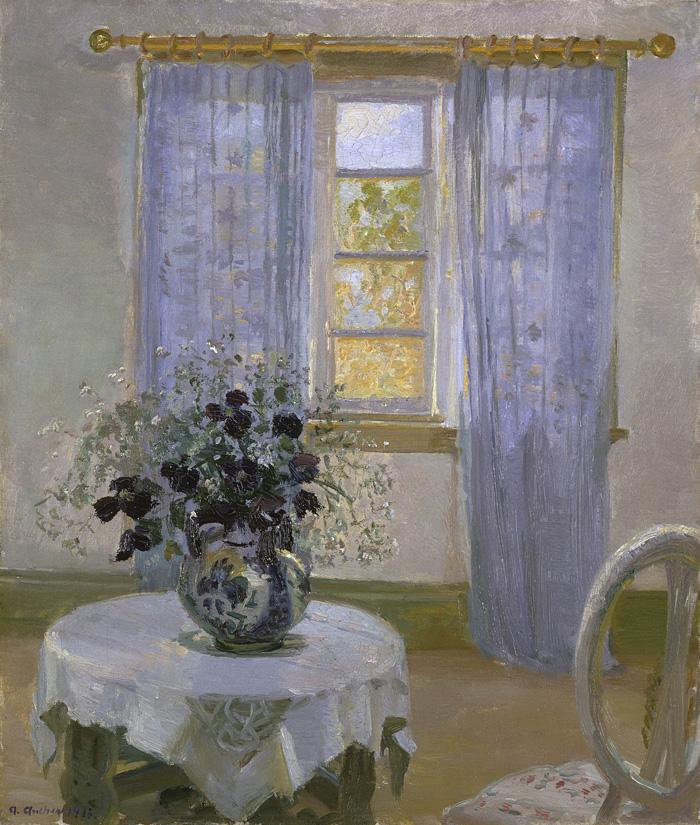
Other areas /
Google Ads
Bedroom politics a century ago…as if art matters |
SUBSCRIBE SEND AS EMAIL |

|
|
|
Anna Ancher
Interiör med klematis, 1913
Interior with Clematis, 1913
Skagens Museum. Photo: Esben Thorning, Jens Jørgen Jensen
|
1 |
|
Reflecting upon matrimony, the poet Samuel Taylor Coleridge once described the happiest marriage he could imagine as “the union of a deaf man to a blind woman.” But what happens when both parties to a marriage not only see and hear very well, but also have pronounced artistic temperaments and extraordinary ambitions?
An exhibit running from March 2 to May 16 at Stockholm’s National Museum called “Artist Couples at the Turn of the 19th Century” explores interesting issues of gender, class and social change. Four well-known artistic couples from Scandinavia are represented: Skagen painters Anna and Michael Ancher of Denmark; Oda and Christian Krohg of Norway; Karin and Carl Larsson of Sweden; and Sigrid Hjerten/Issac Grunewald, also of Sweden. The mix is geographically broadened with the inclusion of Vanessa Bell/Duncan Grant of England, as well as the Scottish couple Margaret Macdonald and Charles Rennie Mackintosh. On display are paintings, textiles, crafts and furniture. The six couples in the exhibit, like artistic couples of today, didn’t always find it simple to combine their professional and private lives. And some of the artists of the previous century had dramatic and fascinating lives. Oda (1860-1905) and Christian Krohg (1852-1925), for example sought to break with bourgeois gender norms of the day, depicting their friends and themselves in paintings of bohemian life in Kristiania (Oslo). Oda, as the exhibit catalogue observes, “came to pay a high price for her role as the Princess of Bohemians,” and especially for living like her male colleagues in free-love liaisons.” Similarly, Vanessa Bell (1879-1961) and Duncan Grant (1885-1978), who are mainly associated with the Bloomsbury group, explored and exploded in their art gender stereotypes of that period. There is no boundary in their work, “between professional and private life for Vanessa and Duncan, always trying to work side by side.” This anti-bourgeois attitude was not shared by everyone. Many in the 1890s viewed the unmanly Dandy personified by Britain’s Oscar Wilde and the sinful “City Woman” as degenerate. Karin (1859-1889) and Carl Larsson, (1853-1919) rejected the lures and dangers of the big city and cosmopolitan Europe; the Larsson’s created a new ideal of domestic bliss and a new aesthetic vision incorporating rural traditions and native handicrafts after moving to the country at Sundborn in Dalarna, where they enjoyed a unique collaboration. But Karin Larsson is in all the images presented as wife and mother, never an artist or designer. “It is therefore a paradox,” the exhibit catalog reflects, “that Sundborn (where the Larssons lived) is viewed today as national symbol for design and a democratic role-model, when one of its creators has been denied the right of recognition, due to its own patriarchal structure.” Another talented Swedish couple represented in the National Museum exhibit, Isaac Grünewald (1889-1946) and his first wife Sigrid Hjertén (1885-1948), are credited with playing a prominent role in introducing modernism to Sweden. In their expressionist works, the couple “attempted to transcend the barrier between private and public space, between fashion, art and design,” the exhibit catalog explains. The couple is also the subject of a new film documentary (see adjacent article). The National Museum is to be commended for placing art in a social and historic context, for connecting anesthetics to politics and moral values, as if art matters. And it does matter. There are many similarities between the personal and professional conflicts experienced by the six artists in the recent exhibit - who were all born in the 1800s - and the problems and challenges of artist couples today. Further info on more recent exhibits at the museum: www.nationalmuseum.com Stormy romance in a turbulent time Issac Grünewald, who was born in Sweden, was because of his Jewish background and progressive ideas about art widely regarded as “un-Swedish.” The artist, who was befriended by Royal patron Prince Eugene as a youth, was the target of virulent anti-Semitic attacks during the 1920s and 1930s. Issac was one of the most well-known and successful artists of his generation, and one of the most controversial. A new documentary called “Sigrid and Issac” by director and scriptwriter Anders Walgren is simultaneously a bittersweet love story and an exploration of social tensions during a turbulent period of history. Actors Gunilla Röör och Philip Zandén lend their voices to the narrative, reading from letters written by the artist couple; the story of their troubled relationship and careers is told in the form of a dialogue. At one point in the film, Stockholm-born Issac asks rhetorically: “Aren’t I Swedish?” It is as if one is listening to a voice from the distant past, taking part in the current debate about multi-culturism, European integration and identity. One of the best places to see Grünewald’s work is at the original home of Prince Eugene, which is now an art museum. Further info, see: www.waldemarsudde.com Written by David Bartal |
Other articles on Art / A Look at Three-Dimensional Scandinavian Art When Claude Monet Did Norway Mirror of Nature Scandinavian Art in New York Cirkus Cirkör gets under your skin East Meets West Queens kids visit Ribe, Denmark Scandinavian art in New York Immigrant Chefs in America Scandinavian at the International Contemporary Furniture Fair in New York
|
800 827 9333 © Copyright Nordic Reach 2008